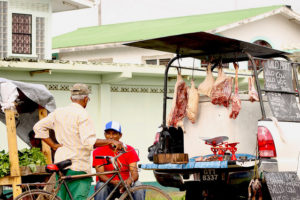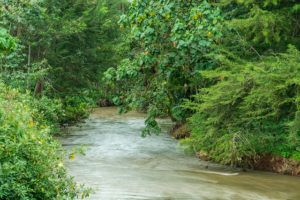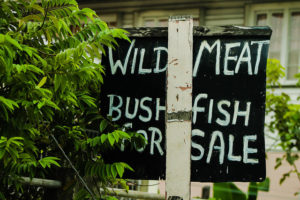
Scientists track the disease to the edge of newly cleared forests.
News of an Ebola Viral Disease (EVD) outbreak strikes fear not only in Africa where it originates, but around the world. In humans, the virus produces severe symptoms such as bleeding from the eyes, nose and mouth, loss of consciousness, seizures and eventual death.
First discovered in 1976 in Central Africa, the worst outbreak happened between 2014-2016 when the virus rapidly spread through Liberia, Sierra Leone and Guinea, killing more than 11,000 men, women and children. Cases were also reported in Mali, Nigeria, Senegal, Spain, Italy, the United Kingdom and the United States. With no known cure, governments must rely on prevention and control strategies to contain new outbreaks.
But in a new study, scientists from the Center for International Forestry Research (CIFOR), Spain’s Universidad de Malaga and other partner institutions have uncovered a vital piece of the Ebola puzzle — when and where outbreaks can occur.
Watch: Let’s talk about bushmeat
TIMING IS EVERYTHING
“Since Ebola is transmitted to humans from wild animals we were initially very interested in the link between the virus and bushmeat practices,” says Professor John E. Fa, a Senior Associate at CIFOR and a Professor at the UK’s Manchester Metropolitan University.
“This led us to the next question: we knew there was no evidence that Ebola happens in cycles, so we asked, ‘What other conditions on the ground are there to encourage this virus to flourish and infect people?’” says Fa.

The team — made up of practitioners, landscape ecologists and modellers, the latter led by Dr. Jesus Olivero of the Faculty of Sciences in Malaga — joined forces to investigate patterns of forest loss in areas where Ebola disease outbreaks had been recorded, and other sites where no outbreaks had occurred. The question to be answered was whether there were substantial differences in the rates and extent of deforestation in these two distinct types of sites.
“The comparison is remarkable. In the outbreak areas, it’s not just more deforestation, but there is also greater forest fragmentation,” says Olivero.
The scientists point out that as large forest blocks are broken up into smaller fragments, this may become an open invitation for new instances of contact to take place between humans and potential natural carriers, thereby increasing the risk of an outbreak.
Although the possible link between forest loss and zoonotic disease has been suggested before, the findings of the present work provide strong evidence of an association between Ebola outbreak locations and deforestation. The breakthrough in the new study occurred when the team noted a pattern in the timing of deforestation prior to the outbreaks.
“For the first time, we saw a direct correlation between forest fragmentation and when EVD outbreaks happen,” says Olivero.
“We found that EVD outbreaks tended to occur in areas that experienced forest loss up to two years prior.”
Read more: Eating and conserving bushmeat in Africa
GETTING A HEADS UP
The research team says the data could lead to the development of an early warning system, which means governments in Ebola risk regions can get a head start on implementing interventions. This is key, because most EVD outbreaks happen in remote, rural communities where there are few resources.
“Once we know where these potential hotspots are, we can create a map showing where an outbreak is likely to occur and mobilize people and resources to monitor local communities,” says Fa.
This means that surveillance and medical teams, as well as community awareness activities, could make preparations in identified high-risk areas before the virus strikes and, in doing so, save lives.
AN OUNCE OF PREVENTION

The new study clearly suggests that preserving forested areas must be a high priority for nations throughout the world.
“Tropical rainforests are chock-a-block with species of all kinds, including pathogens, which means that for such a high diversity of animal hosts there are corresponding parasites, viruses, and so on,” notes Fa.
“Our feeling is that once you start playing around with an ecosystem, you might have a flurry of activity of viruses that may even start looking for new hosts,” he adds.
Fa says much more needs to be done to fully understand how EVD outbreaks occur, and how the virus is transmitted. The team is currently looking at how outbreaks may be influenced by climate, and how potential Ebola host animals, such as bats, may be linked to deforestation.
“It is now fundamental to go to the field to find out what creates disease flurries, and also to do more research into different types of forests with different levels of deforestation. We need to know what happens to the species, what happens to the virus, in these areas,” he says.
Fa adds that it’s crucial to look at the big picture, at how emerging infectious diseases like Ebola are moving out of remote areas and infecting the general public, and the role that nature plays.
“We see the importance of keeping biodiversity intact,” he concludes.
Watch: Future solutions for bushmeat in Colombia
By Suzanna Dayne, originally published at CIFOR’s Forests News.
This research is part of CIFOR’s Bushmeat Research Initiative. For more information on this topic, please contact John E. Fa at jfa949@gmail.com or Jesus Olivero at jesusolivero@uma.es.
This research forms part of the CGIAR Research Program on Forests, Trees and Agroforestry, which is supported by CGIAR Fund Donors. It is also supported by UK aid from the UK Government and USAID.











